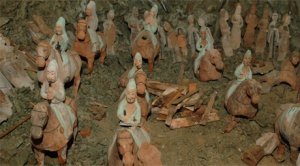 In Mongolia, Kazakhstan and Mongolian archeologists discovered a mausoleum of an ancient Turkish emperor. The find, dated to 7th century, is sensational in itself, as scientists of the world confirm. The mausoleum was preserved in the original state and was not damaged during the excavations, which is due in many ways to a new method invented together with Mongolian scientists. Karzhaubai Sartkozhauli, Doctor of philology, professor, and director of Gumilev scientific research center "Turkology and Altaistics" of ENU called it a skill of scientists of two countries.
In Mongolia, Kazakhstan and Mongolian archeologists discovered a mausoleum of an ancient Turkish emperor. The find, dated to 7th century, is sensational in itself, as scientists of the world confirm. The mausoleum was preserved in the original state and was not damaged during the excavations, which is due in many ways to a new method invented together with Mongolian scientists. Karzhaubai Sartkozhauli, Doctor of philology, professor, and director of Gumilev scientific research center "Turkology and Altaistics" of ENU called it a skill of scientists of two countries.
"Turkic culture has not changed much in centuries. As you know, our ancestors built yurts in such a way that the entrance faced south-east. The door of the corridor leading into the mausoleum also faced south-east. When we began our research, it became clear in which manner the ancient Turks of 1300 years ago dug out and buried again the underground object. I have to note that archeologists Zhantegin Karzhaubaiuli (Kazakhstan) and Erdenbold (Mongolia) fully preserved the appearance and architectural structure of the mausoleum of ancient Turks of Early Middle Ages. It is due to the long process and detailed painstaking labor of the entire group of 34 people, - explained Sartkozhauli.
There were no steps in the 42 meter corridor, but the walls had drawings on both sides and there were four arches 100-150 cm thick. It is a rare unique object, as Kyrym Altynbekov, the artist-restorer explains.
The excavations took two months, then another month was necessary for conservation of the discovered specimens. There were about 352 objects found in the mausoleum. Among them were precious jewelry, paintings, domestic objects. "Terracotta" figurines and their distribution in one of the chambers of the mausoleum are of special interest. "When we entered on of the chambers of the mausoleum, we saw about 90 little statues standing in four rows. They are symbolic of the funerary ritual. But it still has to be thoroughly studied. But just the find itself is evidence that already in 6th - 7th century ancient Turks had this type of art (making of terracotta sculptures), who may have been the first to use it", - Altynbekov said.
As Sartkozhauli notes, the construction and furnishing of the underground mausoleum Maikhal-uula in Central Mongolia is characteristic only for local Turkic people. There is no influence by Chinese or Sogdian craftsmen. This is evidenced by the originality of the layout, sculptures, drawings, patterns and decorations by the craftsmen. "Chinese wall frescoes have been preserved only in towns west of Dun-Huang. Drawings of Western China date to 9th - 13th centuries of our era. However, the Maikhal-uula mausoleum was built in 7th century, and therefore the wall drawings are the heritage of the Great Steppe. Of course, influence of Chinese, oriental culture cannot be totally excluded,, and, I would say, is unavoidable. But the historical-cultural treasures, found in this underground mausoleum belong to us, and are a national cultural heritage of the whole Turkic world", - concluded the scientist.
The most interesting aspect is that foreigners were the first ones to become interested in the Turkish mausoleum : curious scientists from Germany, China, USA, as soon as they found out about this historical object, immediately arrived and even envied such an ancient find. "About 30 expeditions from various countries are working in Mongolia in parallel right now, and all of them remark on the unique and sensational features of this discovery. But now, to preserve it, a museum has to be built, with all the necessary conditions. The government of Kazakhstan should start working on this matter now", - says Sartkozhauli.

